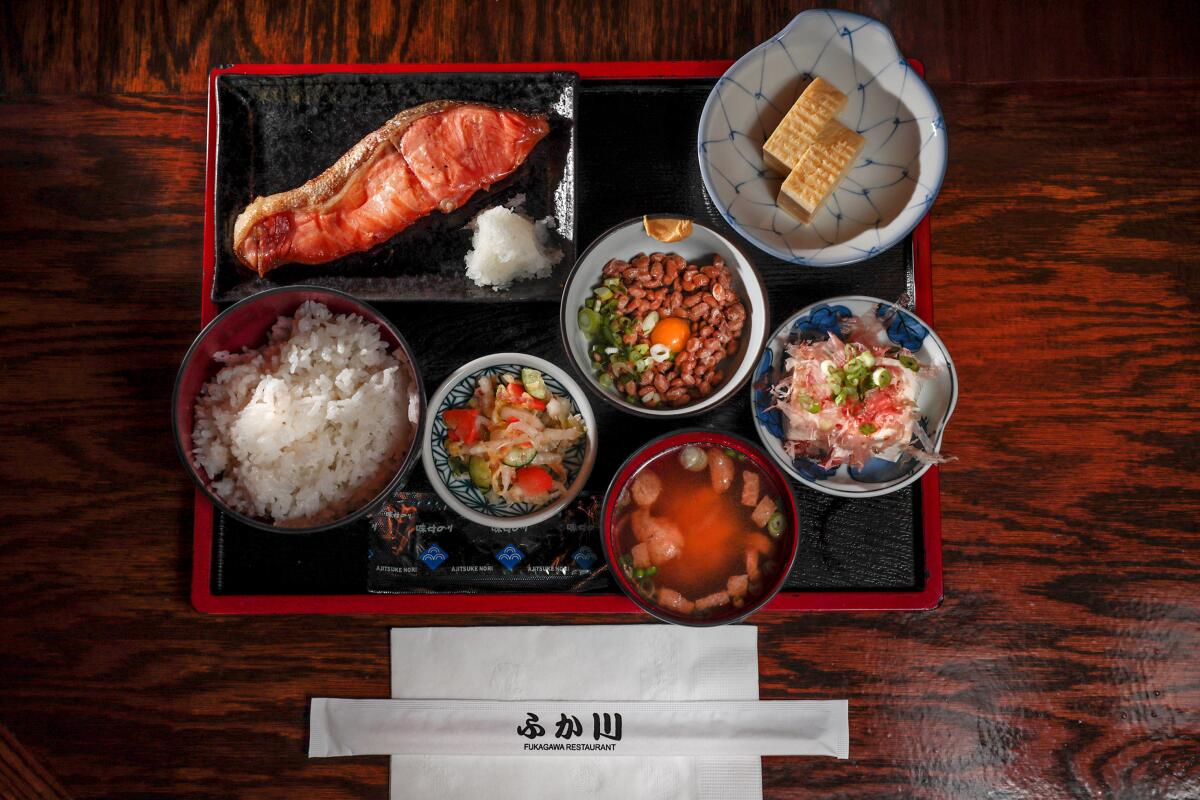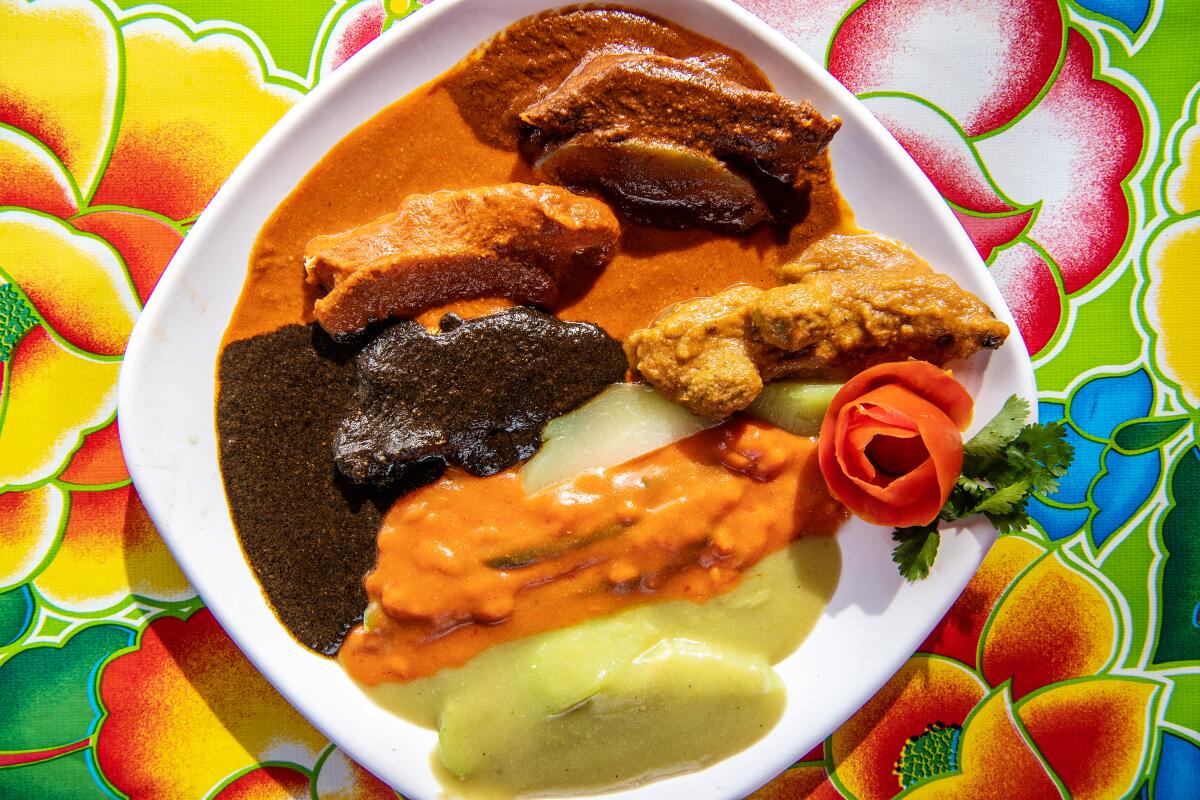Where to eat a traditional Japanese breakfast in Los Angeles

I love morning foods of all kinds, and I worked through college scrambling eggs and cranking out waffles at a bed-and-breakfast in Boston. These days, though, after work meals out most nights, I rarely wake up wanting more than a few spoonfuls of yogurt or a handful of peanuts.
Eat your way across L.A.
Get our weekly Tasting Notes newsletter for reviews, news and more.
You may occasionally receive promotional content from the Los Angeles Times.
When hunger does call early in the day, I’ve lately been finding my way to Azay, a small Japanese-French restaurant in Little Tokyo that opened a few months ago.
Chef-owner Akira Hirose serves bento boxes and soba for lunch — and also veers into duck confit and boeuf Bourguignon — but his asa gohan (breakfast) menu centers around a traditional combination of dishes. A small hunk of broiled fish, often mackerel, sits in the center of a black lacquered tray surrounded by modest portions of miso soup, dashimaki tamago, tofu topped with bonito and tsukemono (salt pickles, made with a rotating cast of vegetables). It’s everything I want in a workday breakfast: fortifying, nourishing and rousing in its variety, but also not too much food.
Azay is one of the few Los Angeles restaurants I know of that serves a traditional Japanese breakfast set — a variation on ichiju sansai, an array that consists of soup, rice and several side dishes — but the meal has been slowly making more appearances across the city. Hotel breakfasts in Japan can become elaborate feasts; the teishoku (set meal) breakfasts available in restaurants in L.A. tend to be more attuned to median appetites, presenting five to seven savory dishes direct in their seasoning and appeal. Their broadening presence is another expression of our profound and ever-evolving Japanese dining culture.
Fukagawa, hidden down a walkway in the center of Gardena’s rambling Pacific Square Shopping Center, has long been one of the region’s only reliable sources for Japanese breakfast sets. The restaurant has four combinations featuring eggs (dashimaki tamago, sunny side up or scrambled), grilled fish (salmon or mackerel) or steak, natto (fermented soybean condiment), cold tofu, miso soup, pickles and rice. Combo D brings you some of everything; it’s my standard order. The portions are more generous than at Azay; the restaurant serves breakfast into early afternoon. I’m more likely to eat this spread for lunch.
Akira Akuto and Nick Montgomery hijacked Instagram late in 2008 with their tributes to Japanese convenience-store sandwiches at Konbi in Echo Park. The cooking reaches well past photogenic egg salad sandos: exquisite, austere vegetable dishes; chocolate croissants served hot; deeply caramelized canelés; and a custardy date tart from pastry chef Jen Yee. Last year Akuto and Montgomery added gorgeously composed Japanese-style breakfasts: One meal in July included broiled black cod perfumed with yuzu, dashi omelet, eight-grain rice, broccolini with sesame and almond dressing.
Konbi has 10 seats, and Akuto and Montgomery recently decided that the full breakfasts were too taxing on their tiny kitchen to execute consistently. They’re working on some rice-based dishes riffing on their sets. I’m still hoping they might consider bringing back the traditional breakfast as a special now and then.
Echo Park hasn’t quite lost its Japanese-style breakfasts yet. In November chefs Todd Chang and Johnny Lee began collaborating on Gatsu Gatsu, a monthly pop-up focusing on teishoku. Their first two menus came with either salmon shioyaki (in which the fish is salt-cured and grilled) or gindara nitsuke (black cod simmered in shoyu) along with the classics: rice, pickles, seasonal vegetables and miso soup. Their approach to produce can lean slightly more intricate: agebitashi eggplant, pumpkin, sweet potato and bell pepper (flash-fried and then marinated in dashi), turnips and their greens in miso-citrus sauce, greens in sesame sauce.
“For us, teishoku just made sense as a response to the everyday hustle experienced by your average Angeleno,” Chang said via email. “Its many many components, all served at the same time, almost demands our guests’ attention.”
Chang and Lee are considering either Jan. 19 or Jan. 26 for their next installment. Check their Instagram for updates. I can walk to their pop-up space from my apartment; I’ll likely see you there.
Ask the critics
The great late chef John Santi once told me that the presentation and look of the food accounted for half the taste. Do you also believe this?
— Mike H., email
Aesthetics and the idea of “we feast first with our eyes” has never been more important to a larger swath of people. But if this is about whether I feel that spectacular visuals account for how I register flavors? The answer, for me, is no.
Appearance can affect my mood: sedating or rousing or depressing or intriguing. My brain can say, “That looks amazing, I can’t wait to put that in my mouth.” But the taste buds don’t lie. An architecturally riveting plate of food can have the texture of Styrofoam and taste like nothing. A murky brown stew layered with vegetables and meats and spice often delivers way more satisfaction than edible sculptures. You can put the stew in a beautiful ceramic bowl to add an element of beauty — and that’s fine — but I care much more about how the stew tastes than how it looks. A formless brown stew doesn’t taste half as delicious to me.
And of course it’s wonderful if something tastes as spectacular as it looks. I’d say 97% of the things on my Instagram account fall in this category — in other words, I don’t post pretty pics of food that doesn’t also taste great to me. There have been concerns that traditional foods of many heritages might disappear in a culture that puts so much value on the phone pics they snap; I honestly don’t believe that’s happening yet on levels high enough to cause serious concern (at least, not in Los Angeles). If the tide turns, I’ll start loading up my Insta feed with foods that strike me as important and deeply satisfying, looks be damned.
Have a question for the critics?
Top stories

— Patricia Escárcega goes brilliantly deep on the subject of moles this week. Do check out her story, as well has her list of places to eat excellent moles in L.A.
— Andrea Nguyen riffs on moles with tips on cooking with mole pastes; as Nguyen makes clear, there’s no shame in using them!
Enjoying this newsletter? Consider subscribing to the Los Angeles Times
Your support helps us deliver the news that matters most. Become a subscriber.
— Genevieve Ko joins the conversation with a recipe for fig mole from Christy Kujan of CaCao Mexicatessen, and tells you which parts of the chicken are best to use for the dish.
— Jenn Harris introduces “I Can Make That,” in which she decodes some of her favorite restaurant dishes for the home kitchen. First up: the beloved off-menu Jazz Burger at Jitlada.
— Jenn and Lucas Kwan Peterson lead a fast-burger smackdown, meat-free edition.
— And finally, Ben Mims gives us a pasta dish that would fit almost any January-resolution diet.
Eat your way across L.A.
Get our weekly Tasting Notes newsletter for reviews, news and more.
You may occasionally receive promotional content from the Los Angeles Times.



